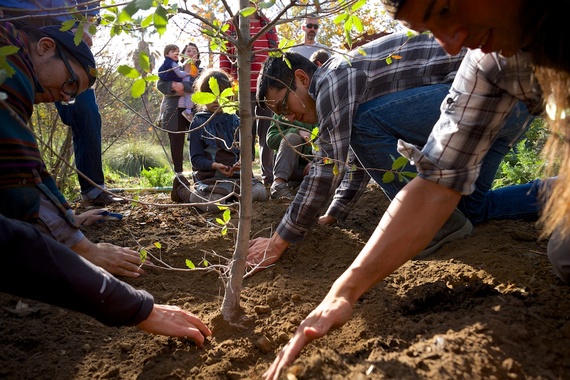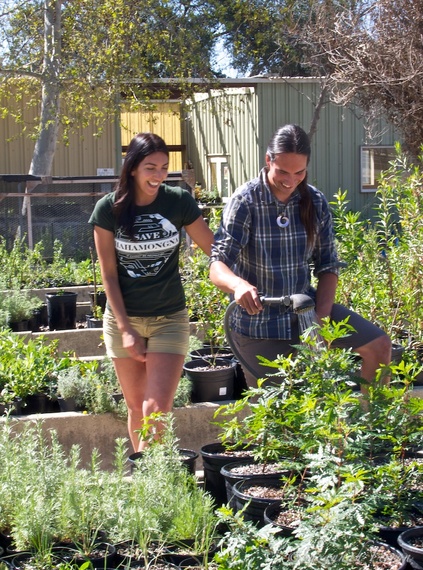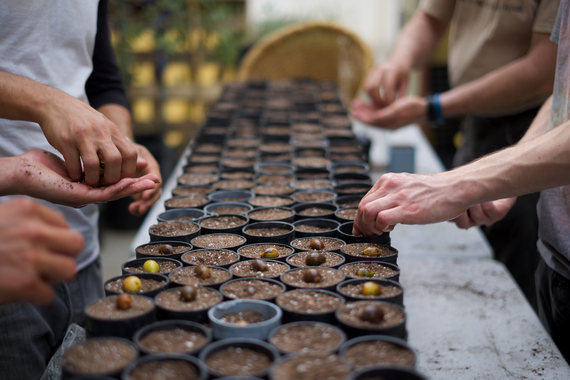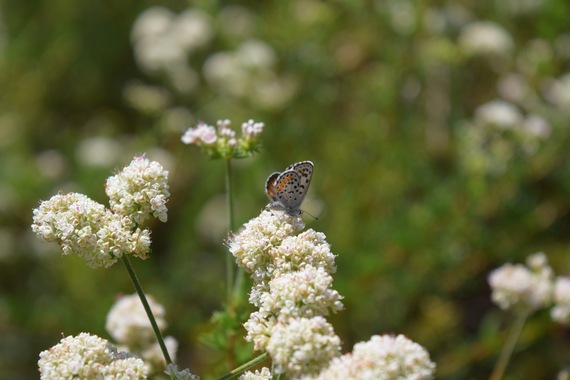Pinyon syrup; acorn and cattail crackers; golden currant wine; mountain trout with Manzanita berries and willow bark. Wild-foraged foods are becoming increasingly popular as adventurous foodies connect ancient food-gathering traditions with the local terroir.
But unless you have access to private lands, much wild food foraging is illegal. Native plants are protected, and harvesting them is poaching. Try the easy alternative to poaching in our public spaces and parks -- grow edible plants at home! We need more native plants, not fewer. Besides feeding yourself, you'll also support the native butterflies and birds that depend on these foods. We can forage in our gardens!
When people harvest native plants in our struggling Southern California ecosystems, their impact on the plants, and the insects and animals that need them, is devastating. Taking bark, leaves, seeds, nuts and berries weakens the plants' abilities to renew themselves, reproduce, and survive brutal drought. By harvesting elderberries, for example, there are fewer berries to feed birds and other animals, fewer berries to nourish the soil, fewer berries to fall to the ground and make more trees or be transported in scat or droppings to grow in other locations.

Planting a new oak tree, which may house frogs, salamanders, mountain lions, gray foxes, robins, woodpeckers, owls, eagles, egrets, herons, roadrunners, and hundreds more species of local wildlife.
Photo: Chadd Ferron
California habitats already face multiple threats: development, drought, invasive-non-native plants and insects, loss of groundwater, and ever-more-frequent wildfires. Foraging is another nail in the coffin -- a coffin we should try to dismantle rather than seal shut. California is a biodiversity hotspot. One-third of California's 6,000 species and subspecies of native plants are endemic, found nowhere else in the world. The native plant species being foraged for cocktails, pickles (such as unripe Southern California black walnuts), and condiments are already threatened and endangered due to other human activity. We can't afford for even an infinitesimal fraction of the 23 million people in Southern California to forage native plants on already stressed public wild lands.
Indigenous Californian Nicholas Hummingbird directs the Hahamongna Cooperative Nursery in Pasadena, where he and his volunteers have propagated 10,000 individual plants. He has painstakingly and sustainably hand-collected seeds and cuttings from 200 local native species, many of them the very ingredients found in forage and wild-crafted recipes. His spectacular Instagram account is "dedicated to advocating for California's native plants, animals, & landscapes. They need our voice."

Nicholas Hummingbird and Monica Reyes make sure saplings of native trees and bushes get a good start at Hahamongna Cooperative Nursery.
Photo: Suzannah Ferron
Nicholas encourages, "Bring native plants into your life by doing something small and simple in your yard. You don't need to go out in the wild to enjoy native plants. At home, you can rekindle thousands of years of relationships between humans and the land. Even tiny spaces can provide habitat and beauty. I removed a few pavers from my apartment patio to grow seeds and cuttings. I eat my breakfast outside with butterflies, hummingbirds, ladybugs, and lizards. Restoring pocket habitats will entice native animals and birds to return, and to have some respite in our cities." Nicholas explains that growing natives at home helps preserve species, such as California black walnut and golden currant, that could go extinct in our lifetimes. "When plants go extinct, the bees, birds, and animals that depend on that plant go extinct also. We may lose 3,300 species in the next twenty to thirty years."
"I've worked with native plants a majority of my life. Now, I find advocating for the rights of the plants and animals imperative. Indigenous people in California went through two waves of genocide. The plants, the animals and the land are still going through that same genocide, which has only accelerated. Plants and animals are exploited and exterminated without a voice to fight for their rights to exist. I'm intimate with the land. A part of who I am is based on these plants. They have a language. When they are gone, when they are silenced and killed, that part of myself, along with thousands of years of culture, dies too."
"Native plants give us a sense of place, of where we live and where we come from. Our local mountains are held together by the vast root systems of native plants. They support the butterflies and bees, the birds and native pollinators that so many people love. A beautiful California native oak takes only the water it needs, sequesters carbon, and gives habitat and food to hundreds of beneficial species of insects, birds, and animals. Foxes, woodpeckers, endangered amphibians.
Each oak functions as a community -- providing food, shelter and resources for hundreds of species. In the Los Angeles basin, millions of oaks inhabited the landscape, but were quickly clear cut, chopped down and dynamited to make room for invasive grass for non-native cows and grazing animals. The few remaining oak woodlands are still under incredible pressure. Our native oaks stand testament not only to our own lifetimes, but to six or seven generations to come.
Here in Pasadena, the Englemann oak has been severely impacted and is nearly extinct. So instead of eating the crop that appears every two years, we've worked hard to collect acorns from the few remaining trees. Our responsible approach to propagating the acorns will germinate a few hundred new trees."
An oak tree can be an entire community.
Photo: Nicholas Hummingbird
"Foraging in the wild has a very detrimental impact. Animals avoid a place where humans have been for several hours, and if a dog has been there, wild animals will avoid the scent of the new predator for days. By foraging, we remove the animals' food supply.
Here at Hahamongna Watershed Park, foragers constantly hold workshops. Our nursery has taken a watchdog role, assessing the impacts of foraging on the health of local elderberry trees and other plants. For example, thirty-two mature elderberries had been loaded with ripe fruit, ready to feed the birds and animals doing their best to survive this drought. Two days after recent foraging events, people had stripped the trees completely bare of not only the fruit, but also the flowers. It's very discouraging for our volunteers, who work hard to grow native plants for restoration and to learn the ethics of stewardship, to witness the greed and exploitation in this place our volunteers care for.
"Don't further destroy the last remaining natural places. We need to bring nature back into the city. Advocate for native plants you'd like to see used in community gardens and landscaping. At Hahamongna Cooperative Nursery, we teach respectful ways to interact with plants. For instance, elderberries are easy to grow at home. If you give the tree water during the summer, it will yield fruit all year. Wherever you'd have room for a crepe myrtle, you have room to grow and protect a black walnut, which is very endangered. Seeing people gather the walnuts for food makes me angry -- there just aren't enough. At the nursery, when we gather acorns and walnuts, we gather them to grow, not to eat!

Nursery volunteers prepare acorns for sprouting new trees.
Photo: Chadd Ferron
Lisa Novick, Director of Outreach of the Theodore Payne Foundation for Wild Flowers and Native Plants, has landscaped at home with native plants. She and her family harvest in their beautiful forage garden. Lisa's elderberry tree "attracts all kinds of butterflies because its flowers are like landing pads. Once the flowers start developing into berries, the tree attracts every berry-eating bird out there -- mockingbirds, band-tailed pigeons, finches, spotted towhees, scrub jays. I make infusions from the flowers straight from the tree, or cook the berries to make sauce, jam and pies."
She suggests, "Grow golden currant instead of a rose bush. The golden currant's yellow tube-shaped flowers are great for hummingbirds and other pollinators. The currants are edible right off bush, sweet but tart. For tea, grow white or black sage, which are also great in roast potatoes or chicken. Lisa recommends another favorite. "Buckwheat is great for pancakes. Crush the pompoms of dried flower petals and seeds and use it as flour. Buckwheat blooms vigorously all summer and then provides seeds for birds all fall and winter. The caterpillars of many species of blue butterflies eat buckwheat leaves and blossoms. By planting buckwheat at home, you feed not only people, but caterpillars, which feed baby birds. And since we are in a sixth mass extinction, we need to help other creatures beside ourselves!"

Planting buckwheat at home is great for us and for the pollinators too!
Photo: Lisa Novick
Lisa reminds us, "Native plants are adapted to local soil and climate, and won't need soil amendments, fertilizers or pesticides. Once established, water deeply but infrequently during the dry season. Other useful and easy to grow native plants include mugwort, native grape, and wild strawberry. The California bay laurel tree has a scent that combines pepper, mint, and bubblegum. Kids love it."
Explore these delicious and beautiful native plants while supporting habitat. Bon appetit!
Follow Nicholas on Instagram: https://www.instagram.com/_native_hummingbird/
Nicholas welcomes visitors on Sundays for nursery Volunteer Day: http://www.arroyoseco.org/nursery.htm
At the Theodore Payne Foundation, http://theodorepayne.org/ nursery staff will be happy to advise you on plants to match your site and interests. And, continue to ask for natives wherever you shop for garden supplies. Bon appetite!
http://www.cnps.org/cnps/grownative/where_to_buy.php

